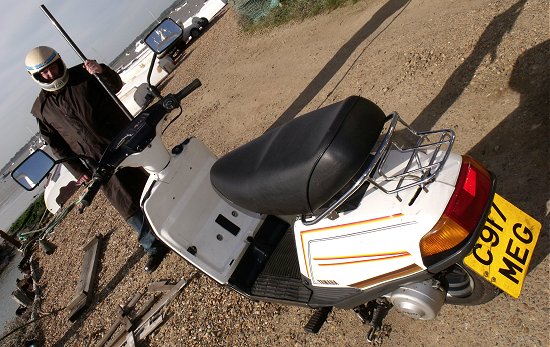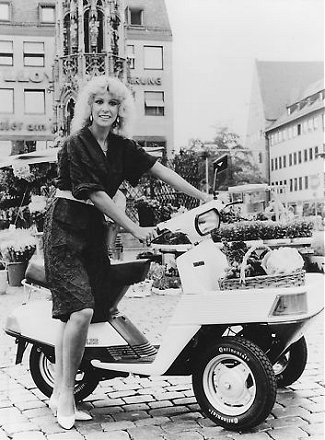

Pitching onward into the troughs, the bow pounds through the swell, spraying sheets of cold saltwater across the foredeck, and floating spindrift foam along the breeze to fizzle in the rigging. Ahab gathered his collar as he scanned the waves ... then a telltale plume on the horizon. "Avast ye lubbers, thar' she blows boys - the White Whale!"
Association with Herman Melville's 'Moby Dick' might seem an unlikely introduction to our feature on a retro-classic Japanese scooter, but there could be a tenuous connection...
Introduced in 1981, the Yamaha CV80 was among the first of a new 'modern generation' of Japanese scooters that also included other Yamaha models like the Jog, Honda Aero, Spree and Elite series, and Suzuki 50 range. The model was sold widely across the world under different titles: its CV80 serial or as Riva 80 in the USA, City CV80 in parts of Europe (and sometimes under a 'Hercules badge instead of Yamaha), but in Japan, Canada , the UK, Holland, Belgium and Scandinavian countries, more often known as the Beluga. Though this choice of title may have seemed perfectly acceptable in Japanese culture, it would probably appear somewhat ill-chosen to western marketing, and a rather unappealing name to the buying public.
So why are we doing an old Japanese scooter? Well, this machine is actually now over 25 years old, and mysterious though it may seem, may actually be considered as a 'classic' since it represents one of the very first 'new generation' Japanese scooters.
Also, this is the oddball third feature, where we feel we may indulge ourselves with a little 'diversification', and who could resist an archaic retro Japanese scooter named after a white whale, especially considering the colour of our feature bike. Just calling it Beluga might seem tragic enough, but ironically, this one's even white!
Our Beluga is something you really need to sit down to with a nice cup of tea in the sunshine, and take in its general ambiance ... was this ever fashionable? You can only marvel at the delicate finishing touch of that tasteful aftermarket pin-striping ... just trims it off a treat! All the style of a 70's American station wagon! Perhaps a few period decals could set the whole picture off perfectly, maybe 'ban the bomb', a 'peace' symbol, a 'marihuana' leaf sticker, 'Jesus saves'?
Modern scoots have long established telescopic forks as the norm and Beluga's front suspension arrangement of old fashioned leading-links, trimmed by ugly plastic covers, appears most bizarre by comparison. The gaping, cowcatcher front mudguard is particularly striking ... though maybe not so much in any styling sense!
Only in looking back at period machines like the Beluga, can you compare and appreciate how the current scooter has evolved and developed. Today, it may be easy to dismiss Beluga as gruesome and ugly (did anyone ever consider this styling attractive?) but now, things have all turned around - and retro is considered cool again! We're not quite sure if this would quite qualify though ... maybe just too retro?
The engine is buried somewhere deep inside the rear body shell, a 79cc two-stroke with reed valve induction, a gentle 6.8 : 1 compression ratio, and Pozi-lube oil injection into the manifold.
For starting, there's nothing to do but turn on the ignition! No petrol tap, that's vacuum. No choke, that's vacuum operated and automatic too. Just press the electric start button to go ... zig-zig-zig-zig-zig ... but you can wind the motor over for ever ... zig-zig-zig-zig-zig ... no, she won't start - yet one jab on the kick-start and she fires up first time, every time. Even though this bike's fitted with a brand new battery and the starter motor is absolutely fine, it hardly ever starts on the button, just occasionally when the engine's thoroughly hot after you've just stopped. This is actually normal! They were all like this!
Since the electric starter proves so completely useless, it's necessary to resort to the kick-start - fine if the bike is still on the main stand but, when the stand is up, the starter lever tangles with the nearside stand leg on its return arc, which is rather an irritating piece of poor design.
The CV80 represented one of the last scooters operating on a 6 Volt system, after this, everything went over to 12 Volt, and Beluga illustrates exactly why. Even from new, the old 6 Volt set up was just too weak to be effective. The 6 Volt system could just about manage firing the 50cc engine on its smaller sibling, but despite a lowly 6.8 : 1 compression ratio on Beluga, was never up to the job of starting the 79cc big brother. One has to wonder what customers and the dealers made of the starting difficulties. It must have been quite an issue for new machines.
Opening the engine compartment cover to gain access to the spark plug and see into Beluga's cavernous depths requires a crosshead screwdriver. All the vacuum tubes and pipes on the 13mm Mikuni carburetter make it look as if it's being attacked by a black octopus and a 'rating' label stuck to a frame tube indicates maximum power as 3.7Kw so, applying the conversion formula of 1Kw = 1.34bhp, confirms our test machine is one of the early 4.7bhp models, rated @ 6,000rpm.
The rear body shell looks as if it might have been designed on the basis of just a big blob. Even following 60+ years of styled body shapes, a number of modern scooter designs still seem unable to shake off the 'whale tail' look. You'd think they'd have all found what appears right by now (the Italians don't seem to have much problem), but look at some far eastern scoots today and there's still a few pretty gross examples!
The way rear lights have gone is another interesting thing. In the '80s & '90s, rear light lenses just seemed to get bigger and bigger, but now they're pretty much going the complete opposite, and are often little more than tiny LED lamps.

In an unusual impression compared to modern day styling, the spacious seat overhangs the body at the front and rear. Sheltered beneath the rear of the seat is a release lock to hinge the saddle up from the front, and reveal ... just a petrol tank and reservoir bottle for the 2-stroke oil! It's hard to think of many present-day machines built like this, but Beluga is what they may now call an 'old skool' scoot, and pre-dates the conventional design of having a standard cavity to store a crash helmet.
Since there appear to be rust spots coming through the paint on the front panel, we have a little tap around to check what this is made of. Sure enough it is steel, as is the handlebar nacelle, whereas practically any modern scoot would pretty surely be 100% plastic panels. We believe the inside of the front leg shield originally carried some form of lockable glove box, but this was moulded out of plastic, probably became broken, and consequently is long gone.
So, to introduce our latest road tester, who better than Captain Ahab to ride the White Whale!

Much like practically all modern scooters, Beluga is a simple twist-and-go. Just wind open the throttle and you're off, but acceleration is far removed from today's revvy machines. The CVT graduates up its range at quite low revs due to the heavy drive rollers, so the impression is of a torquey delivery to a low, flat exhaust note and muffled induction tone ... except that there isn't really much torque. This feels very much like quite a low power motor hauling a heavyweight body shell. Beluga rather lumbers along at any speed it can manage to build up to. The way the drive ratio variates so prematurely, there's little prospect of the motor ever being revved out. The whole riding experience feels like the engine is over-geared all the time, and the bike simply labours up to whatever cruising pace you settle at, so the overall impression is that it's quite docile.
The overdrive ride means there's never any vibration to contend with, but the real limiting consideration for choosing any cruising pace is dictated not by the engine, but the handling. Just a few bumps often find you wondering where the bike might be going, so there's a tendency to ease off to suit the road condition - it's called a sense of self preservation! Speedo indication proves consistent with pace bike readings right up the range.
Best on flat, crouched, with strong tailwind, 39mph. Downhill run 40mph. Beluga faded on the following uphill climb, down to 23/24 on speedo, by the time it crested the rise. This wasn't entirely unexpected due to the lowly 6.8 : 1 compression ratio, and the six standard 10.3 gramme drive rollers overwhelming the CVT to prevent it changing down to any lower gear.
The strong following breeze that had aided our earlier flat run wasn't so kind when we turned back into the headwind on our return leg. Beluga's pace was markedly blown down as, again, the inability of the CVT to drop its ratio and the low compression took their toll. The motor made heavy labour against the conditions, while the scooter buffeted into the forward gale.
Beluga's handling is really sloshy, to such a degree it practically induces seasickness! The cause of this is very probably a lack of damping, but whether the suspension was made like this, or has deteriorated by hydraulic fluid loss over the years is unclear. Whatever the explanation, Beluga pitches and wallows like a floundering blancmange. A few bumps, and it's rolling all over the road.
Despite a tendency for the back brake to squeak when wheeling the scoot around, both stoppers worked quite satisfactorily.
Because the low power motor is constantly labouring against the over gear ratio, the bike tends to be ridden very much with throttle-on, so the fuel consumption rather suffers as a result - around 70mpg is fairly typical, and not particularly good for such a small capacity scooter.
The forward footplate only caters for the rider, and doesn't extend round enough on either side for any pillion passenger to be able to reach, so there's a pair of rear footrests that fold forward from the body shell.
With a new battery, our lights seemed to function fine in daylight, and the horn produced an eager bleep - but the whole 6 Volt set-up is reputedly another of Beluga's major weaknesses. Excepting the starter, all the other electrics work fine as long as the battery remains good and charged, but when the cells get run down, strange things are likely to happen! The generator output is rated 6 Volt × 48 Watt (maximum at full speed, less at lower revs). Now account the fitted equipment, headlight 25 Watt + instrument panel 15 Watt + taillight 5 Watt = 45 Watts with the lights just switched on. So if you've got a tired battery, guess what happens when you pull on a brake and the 25 Watt stoplight operates, or every time the indicators flash with their two 17 Watt bulbs?

Comparable models from other manufacturers like Honda's NH80 and the Vespa P80X, produced appreciably more power, and left the Beluga somewhat short in the rating stakes. The CV80 engine received an uprate in 1985, mainly including an increase to 16mm carburettor, a less restrictive and revised exhaust design using an expansion-chambered system, cylinder with revised porting and new head, reduction of the variator weights to make the CVT more effective, modified intake manifold and reed cage.
The changes pushed power up to 6.9bhp, for appreciably better acceleration, and top speed increased to 45mph. Improved performance, however, came at further cost to the fuel consumption, reduced to around 60mpg. A side stand was also added to the cycle equipment at the time of change.
The Beluga was only sold in three colours which were available every year in every country - 'Chappy Red', 'Clean White', and 'Crystal Silver'. Yamaha did offer a number of accessories for the CV80, including a windshield kit, then a storage box to fit onto the rear carrier and so provide some storage capacity that the basic machine lacked. Rather strangely, the Japanese market further listed a specialist rack to hold a tennis racket!
Yamaha dropped the Beluga in 1987, though leftover models were still being sold and registered in 1988. So now surviving Beluga models are progressively crossing the 25-year-old barrier, might they becoming collectable as classic scooters?
We took on Beluga as a novelty, but it actually proved an interesting link in the chain to the modern scooter. It's only when looking back at older models like CV80, that you can really see the evolution to what we have today.
Will anyone be preserving examples, or might the odd few survivors become hunted to extinction for their paltry scrap value? Strangely, sometimes more modern machines can be in more danger of becoming lost than older models of vehicle that preceded them.

Next - Continuing the general theme for next edition...
It's smaller, it's slower, and it's still white! This Micro Solution is like some strange little moped, but in slow motion!
[Text and photos © 2011 M Daniels.]


Hercules Werke in Nürnberg, Germany produced its own versions of the Beluga. These were renamed the Hercules City but retained the Yamaha "CV" designation. The Hercules City CV80 was produced from 1980 to 1982 and the smaller capacity version, the City CV50 was produced from 1982 until 1988. Additionaly, Herrcules experimented with a three-wheeler version of the City/Beluga, but this did not progess beyond the prototype stage.
We'd known of our featured White Whale for some years now, and had considered the prospect of some 'tongue-in-cheek third oddball feature' on it for quite a while. The opportunity occurred when the scooter came through the workshops among a job lot of bikes, bought for repair and resale, so we took a brief moment to photoshoot and roadtest the bike before it moved on.
The initial thought was it might just make spoof feature, based on its retro-ugly look, unfortunate 'Beluga' name, and coincidental colour.
Most spare parts are no longer listed, so the machine shop had to produce new guide ramps to restore the CVT mechanism to operation, otherwise it only needed a new drive roller set, battery, extensive overhaul and service.
Once Beluga was up and running again with the prospect of developing a feature now seeming a distinct possibility, a bit of background research revealed it to being a little more interesting than we initially considered.
There was a little story behind Beluga after all.
We were rather expecting its running & riding characteristics to be comparable to modern scooters, but the impression proved markedly different indeed!
The wandering handling and low power/overgeared motor felt worlds apart from today's buzz-bomb bikes, and the CV80 wouldn't actually feel particularly out of place among other usual small capacity machines at typical cyclemotor/autocycle/moped rallies. These events can often attract a fair smattering of generally soulless 1970s - 1990s Far Eastern step-through type mounts, along for the ride and just making the numbers up, so this small and similar period scooter probably wouldn't seem that much different.
At 80cc, Beluga still falls within our general small capacity brief, technically qualifies as a classic at 25 years old, and has fairly comparable performance to many other vehicles attending such events.
Everything happened very quickly with Beluga. It was through the workshops within a couple of weeks, road tested and photoshot in April, then dropped into 'next' at the end of July's Reincarnation feature on the Avanti.
The September publication meant it went completely through our system in barely six months.
Production cost was negligible, maybe just a couple of pounds diesel fuel to Ferry Hamlet for the photoshoot. Since we were still showing another token donation on the books from Jeff Lacombe, the Leicester Enthusiasts score yet another sponsorship credit to clear their slate again.